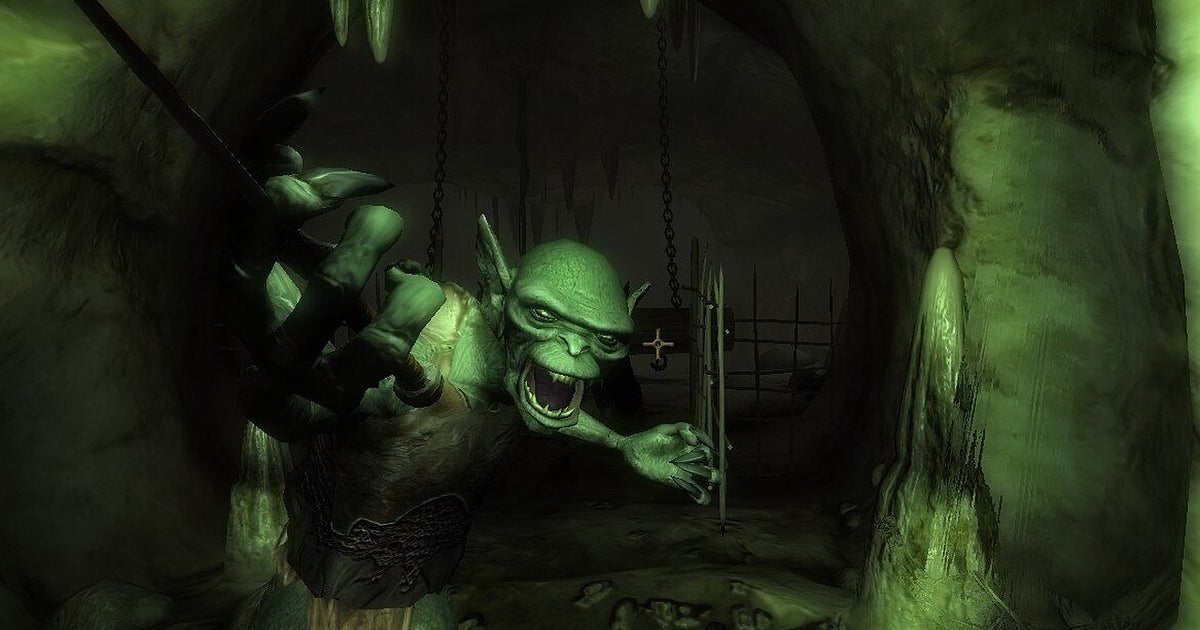Oblivion is famed for its Radiant AI, the gloriously ambitious ant farm that grants all of its friendly NPCs a charming form of scheduled life. In the course of a typical day you’ll find them waking in their own beds, tilling in the fields, breaking off for lunch, and in the case of the deeply paranoid wood elf Glarthir, sneaking round the back of the local church in the middle of the night to plot killings.
But what many players never suspected is that their enemies were living their own lives too. In particular, the goblins: the first truly intelligent opponents you come across in the sewers of the Imperial City, and an invaluable source of door-opening tools in those early hours when your lockpicks seem to snap like reeds.
As it turns out, during all of our days and months engaging in guild antics, delving into dungeons and circumventing the main plotline, the greenskins were engaged in their own activities: goblin wars. These skirmishes play out between seven different tribes scattered across Cyrodiil, and on that fateful day you’re first pumped out of the sewer system like so much excrement, there are already two disputes ongoing – between the Sharp Tooth and the White Skin goblins just outside Skingrad, and between the Bloody Hand and Rock Biters on the Yellow Road. If there’s a recipe for disaster in the goblin community, it’s picking a cave too close to your nearest neighbours.
Why care about the geography? Because there’s a chance you can get caught up in the goblin wars, or even deliberately get involved. The precipitating event for an intraspecies kerfuffle is always the theft of a totem: the spark-firing stick you’ll often find guarded by a shaman, the spiritual head of a given goblin tribe. If a tribe loses their holy staff, they’ll send out a war party to recover it. And if that operation leads them into another tribe’s mineshaft, then there’ll be plenty of casualties, and no sleep for anybody. As a player, you can break in and steal a totem yourself – either to plonk it outside the cave of its proper owner and end hostilities, or plant it somewhere else and let chaos ensue.
The trouble and the intrigue of the goblin wars lies in the fact that they’re not forefronted to you as a player. There’s no declaration on the UI when they begin or end, nor any easy way to track their progress. They don’t happen for the player as an audience; they simply happen, regardless of their presence. That’s led to a number of confused Reddit threads and conflicting wiki entries over the years.
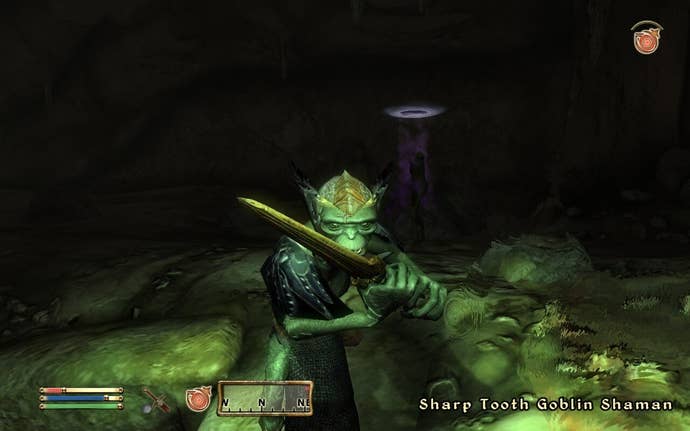
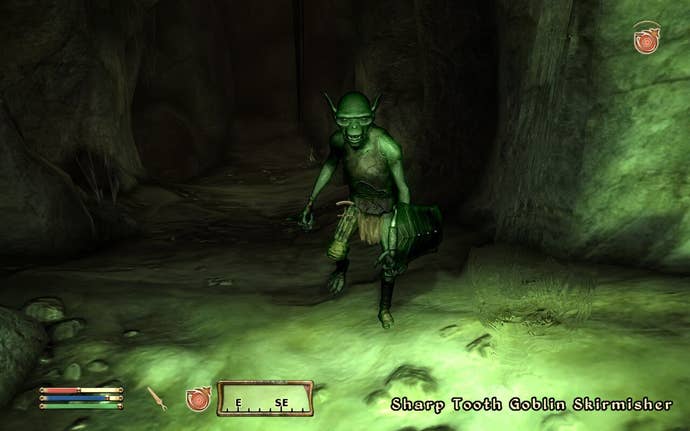
Speaking to the original developers about the goblin wars has been an equally muddy and mysterious journey. I started with Jeff Gardiner, the Oblivion producer and Fallout 76 project lead, who put me in touch with Bruce Nesmith. A Bethesda veteran since the ’90s, Nesmith worked on Oblivion’s creature stats and balancing – but didn’t personally touch the goblin wars system.
“One of the great things about Bethesda’s Elder Scrolls and Fallout games is the freedom designers had to get fun gameplay extras like that approved and implemented,” he told me. “The studio is also infamous for biting off more than it can chew and sometimes such features got scaled back to meet deadlines, leaving partial implementations for enterprising enthusiasts to find.”
At this point, it was tempting to believe that the extent of the goblin wars had been exaggerated by the collective community imagination – overblown as a result of their shadowy, unconfirmable nature. That was until Nesmith tracked down the actual designer responsible: Kurt Kuhlmann, most recently lead systems designer on Starfield.
“This wasn’t a secret feature,” he says. “It was described in the official Oblivion strategy guide.”
Kuhlmann worked on an Oblivion side quest named Goblin Trouble, which concerns a group of settlers who have the misfortune of getting caught in the crossfire between two tribes. “Since I was having to set up a scripted system to get the goblins from one dungeon to periodically attack goblins in another, I figured it wouldn’t be a lot more work to make this systemic, so that it would work with any goblin tribe if the player stole their totem,” Kuhlmann says. “I’m not sure if the part about ‘not a lot more work’ was actually true, but it certainly allowed for fun emergent gameplay. I also liked that it gave you a little bit of insight into the goblin culture and how their tribe was organised.”
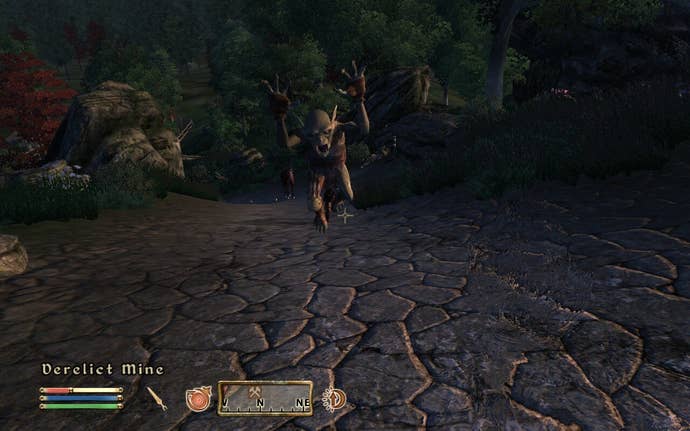
It certainly had the intended effect: through my investigation of the goblin wars, the societal complexities of goblin culture have revealed themselves. Down in their dungeons, I’ve discovered prisons and bedrooms, kitchens and chefs – the latter of whom appear to have their own, combat-avoidant AI. I’ve learned that goblin outposts have spiritual centres, that their warchiefs can be replaced, but that the death of a shaman leaves their tribe passive and listless.
“As I recall, one of the big difficulties was getting the goblins inside the dungeon to be able to come out,” Kuhlmann says. That’s because areas like dungeon interiors in Oblivion aren’t usually loaded when the player isn’t nearby. “I don’t remember how I solved that but apparently I did! Probably with some questionable designer hackery,” Kuhlmann says. “This also took advantage of some of the rarely used but powerful AI features such as ‘Find’, which was how the goblins would head for the totem wherever it happened to be.”
In my own experience, the goblin wars have played out whenever I haven’t been looking. Exploring the derelict mines of the Sharp Tooth tribe, I came across the spot where walkthroughs described invading White Skin raiders, fighting on behalf of a cave-dwelling Breton named Goblin Jim. But neither the raiders, nor the totem they came to collect, were there. The White Skins must have already succeeded in their mission.
After I yoinked the Sharp Tooth’s totem, meanwhile – taking care to leave its attending shaman alive, even as he entered a desperate search state – I left it on the ground outside Skingrad’s gates to see if I could trigger a wider conflict. But while the Sharp Tooths began to flood the road outside their mine, crossing blades with passing Imperial soldiers in the process, they didn’t come for the staff. Maybe that’s because they simply couldn’t fight through the overworld to reach it. Or because I was relying on Oblivion’s ‘Wait’ function to pass them time – much like the YouTuber Rimmy Downunder, who had similar issues with goblin wars.
“I don’t remember the specifics, but the goblin war was stretching the limits of our game systems, especially the AI and scripting,” Kuhlmann says. “My guess is that because of the scripted nature of the goblin wars system, when you use Wait the scripts aren’t getting updated properly.” It might be that the time the goblins set out from their base falls in the middle of a Wait period, and so isn’t triggered when that time is skipped. “You might try short Waits of one hour,” Kuhlmann suggests. “Or just let game time pass naturally and see if that makes a difference.”
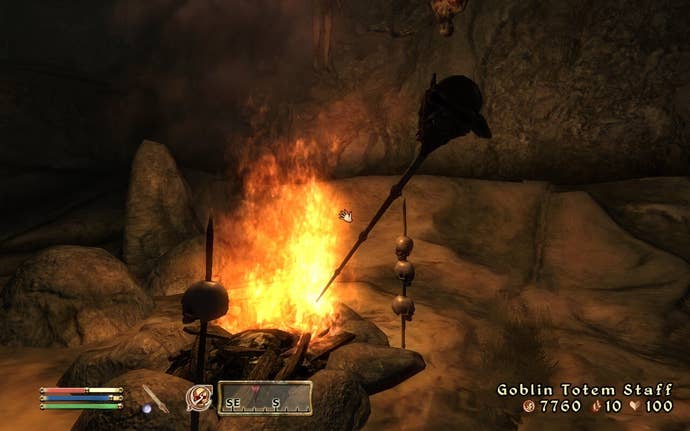
Perhaps it shouldn’t be a surprise that, after Oblivion, the Bethesda team tended to clamp down on “simulationist” systems like this one, due to the number of bugs and other problems they caused. Nevertheless, Kuhlmann continued to build on the goblin wars philosophy wherever possible. He was the designer in charge of Fallout 4‘s workshop feature, which was the source of plenty of unexpected NPC behaviour. If a caravan failed to meet up with another base to deliver supplies, the best solution was to follow its path along the streets of Boston, acting as its guard when passing raider camps and supermutant-riddled department stores.
“I always liked emergent systems that let the player interact with the world and let things happen naturally,” Kuhlmann says. “One of my favorite games is Far Cry 2, where the roving patrols, propagating fire and enemy bases could all interact in unexpected and very fun ways.”
You’ll see spiritually similar instances of AI interplay even in later Bethesda games. “I took my opportunities to introduce whatever elements of ‘controlled chaos’ whenever I could,” Kuhlmann says. “The vertibirds in Fallout, and dragons in Skyrim, were also both sources of great emergent gameplay as they would randomly encounter things and get in fights that you could watch from a distance or join in the fun.”
As for the goblin wars he instigated? Kuhlmann is pretty happy with how they turned out. “There wasn’t much else like it in Oblivion, where you could freeform mess with the world state and have it react in an understandable way,” he says. “I would have loved to do more of that kind of thing but we didn’t have any extra time – in fact the opposite – and also the tools for doing that kind of thing in Oblivion were very primitive.”
More primitive, it transpires, than the goblins themselves. Next time you scrap with a greenskin, spare a moment to wonder: are its motivations more complex than your own?
